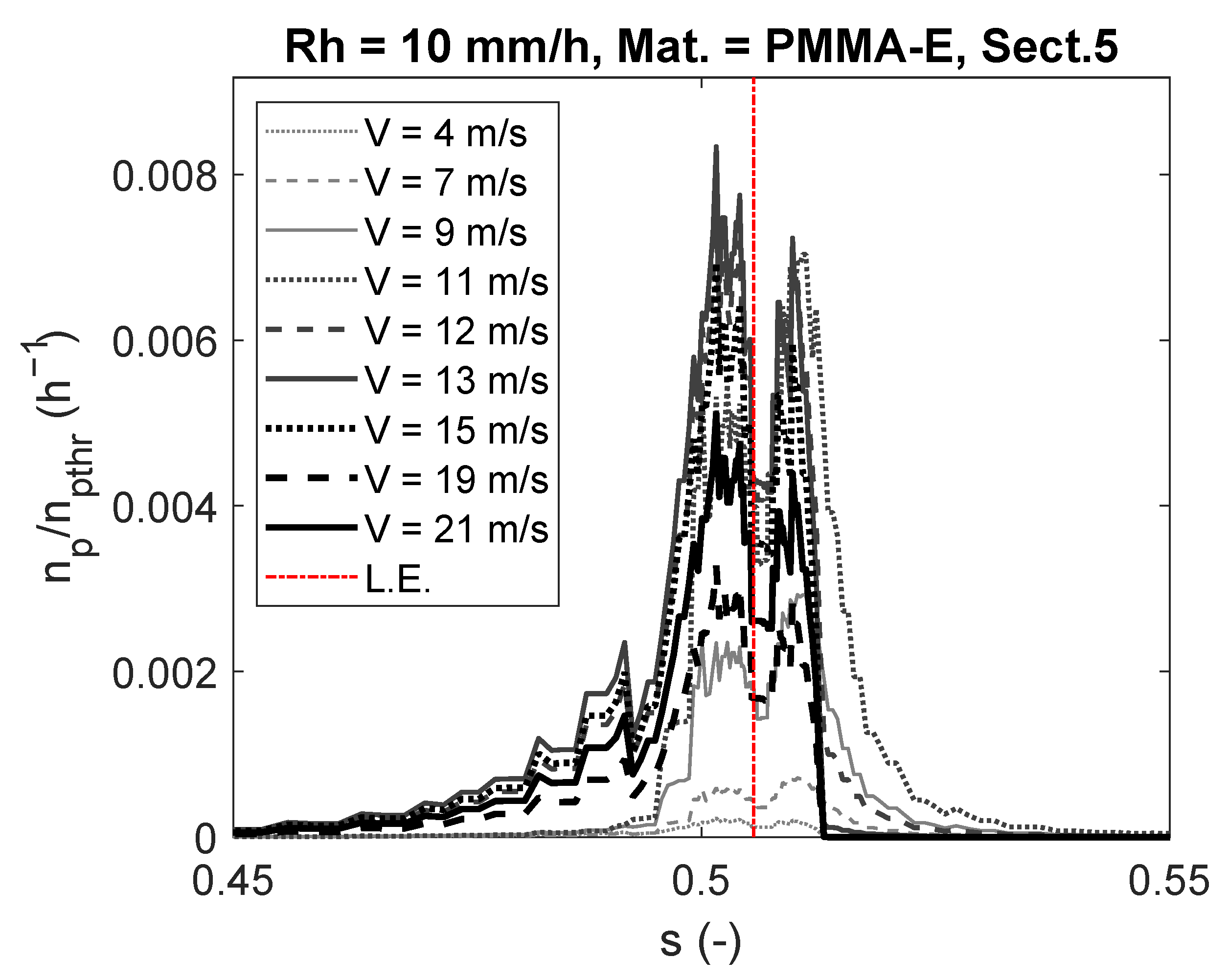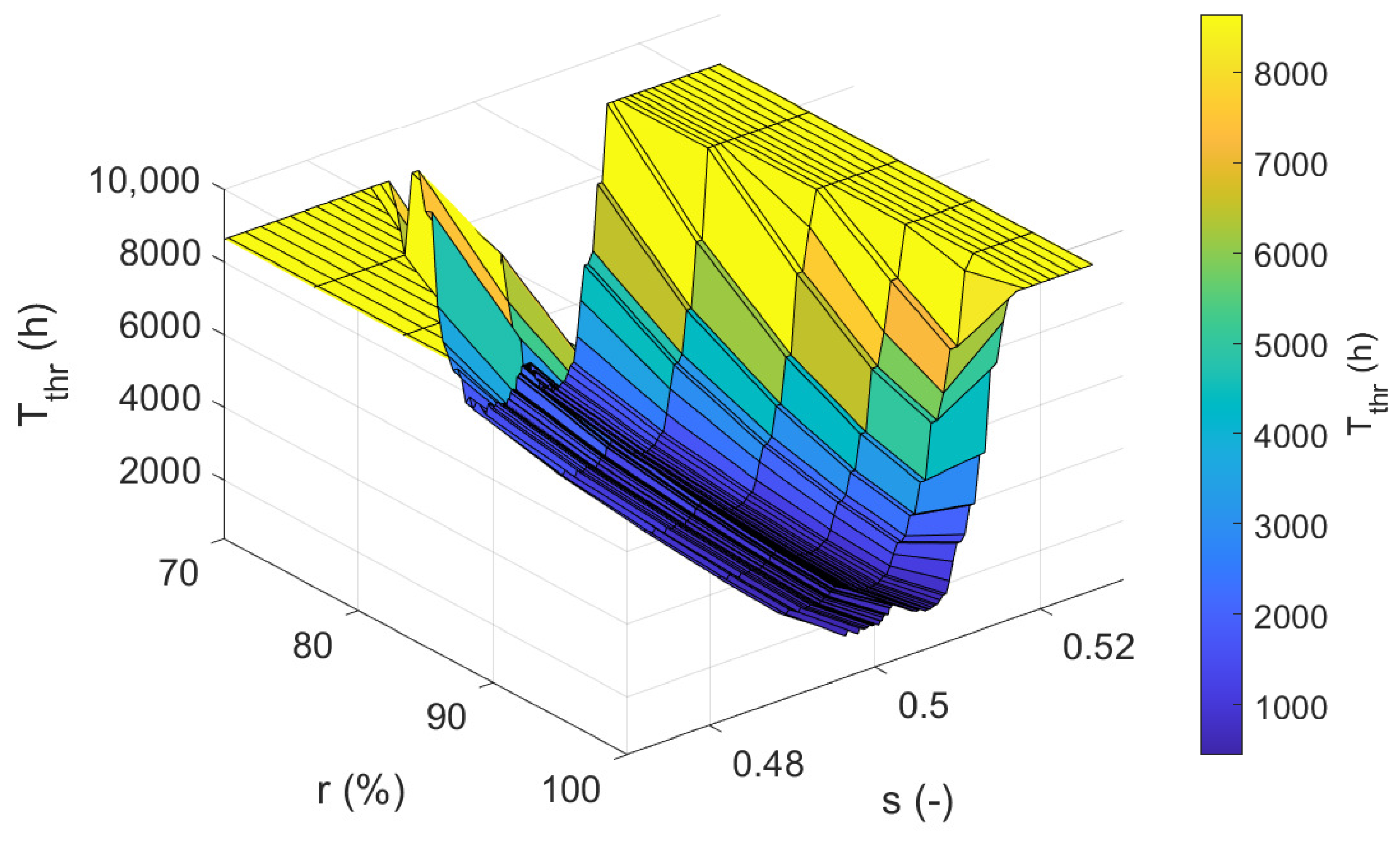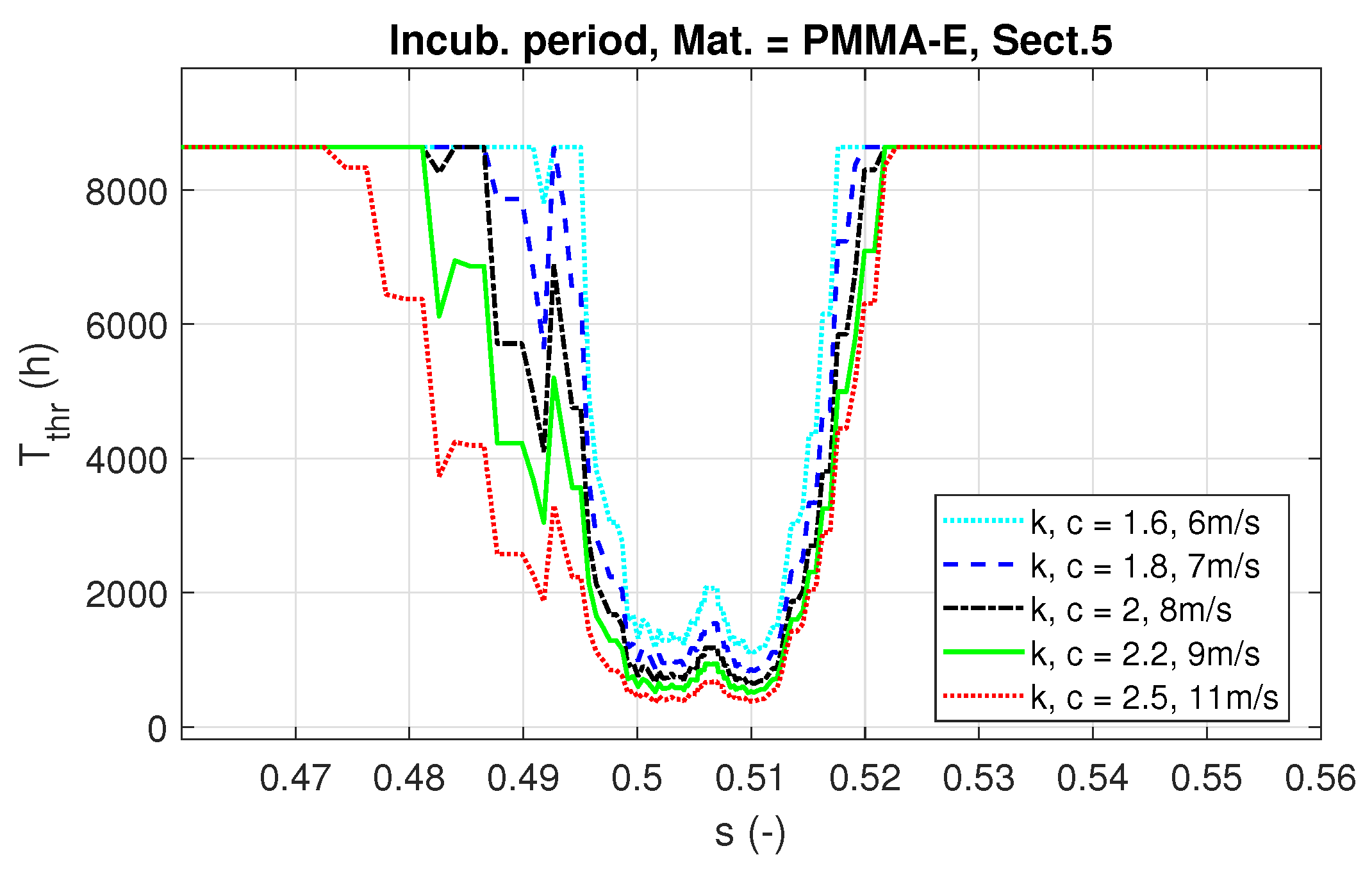Generation of Surface Maps of Erosion Resistance for Wind Turbine Blades under Rain Flows
Abstract
:1. Introduction
2. Materials and Methods
2.1. Methodology
2.2. Erosion Model Tuning
2.3. Test Case
3. Results
3.1. Erosion Damage Incubation Maps
3.2. Application for a Specific Installation Site
4. Conclusions
Author Contributions
Funding
Institutional Review Board Statement
Informed Consent Statement
Data Availability Statement
Conflicts of Interest
References
- United Nations. Glasgow Climate Pact. In Proceedings of the Conference of the Parties Serving as the Meeting of the Parties to the Paris Agreement, Glasgow, UK, 31 October–12 November 2021. [Google Scholar]
- United Nations. Paris Agreement. In Proceedings of the Paris Climate Change Conference (COP21), Paris, France, 30 November–12 December 2015. [Google Scholar]
- IRENA. World Energy Transitions Outlook 2022: 1.5 °C Pathway; International Energy Renewable Agency: Abu Dhabi, United Arab Emirates, 2022. [Google Scholar]
- WWEA. Global Wind Installation. Technical Report. Available online: https://library.wwindea.org/global-statistics/ (accessed on 31 May 2022).
- IRENA. Future of Wind, Deployment, Investment, Technology, Grid Integration and Socio-Economic Aspects (A Global Energy Transformation Paper); Technical Report; International Renewable Energy Agency: Abu Dhabi, United Arab Emirates, 2019. [Google Scholar]
- Oettinger, G.H. Energy, Roadmap 2050; Technical Report; European Commission: Luxembourg, 2011.
- Enevoldsen, P.; Xydis, G. Examining the trends of 35 years growth of key wind turbine components. Energy Sustain. Dev. 2019, 50, 18–26. [Google Scholar] [CrossRef]
- Igwemezie, V.; Mehmanparast, A.; Kolios, A. Current trend in offshore wind energy sector and material requirements for fatigue resistance improvement in large wind turbine support structures—A review. Renew. Sustain. Energy Rev. 2019, 101, 181–196. [Google Scholar] [CrossRef] [Green Version]
- Cappugi, L.; Castorrini, A.; Bonfiglioli, A.; Minisci, E.; Campobasso, M.S. Machine learning-enabled prediction of wind turbine energy yield losses due to general blade leading edge erosion. Energy Convers. Manag. 2021, 245, 114567. [Google Scholar] [CrossRef]
- Dalili, N.; Edrisy, A.; Carriveau, R. A review of surface engineering issues critical to wind turbine performance. Renew. Sustain. Energy Rev. 2009, 13, 428–438. [Google Scholar] [CrossRef]
- Rempel, L. Rotor blade leading edge erosion-real life experiences. Wind. Syst. Mag. 2012, 11, 22–24. [Google Scholar]
- Mishnaevsky, L., Jr. Toolbox for optimizing anti-erosion protective coatings of wind turbine blades: Overview of mechanisms and technical solutions. Wind Energy 2019, 22, 1636–1653. [Google Scholar] [CrossRef]
- Verma, A.S.; Noi, S.D.; Ren, Z.; Jiang, Z.; Teuwen, J.J.E. Minimum Leading Edge Protection Application Length to Combat Rain-Induced Erosion of Wind Turbine Blades. Energies 2021, 14, 1629. [Google Scholar] [CrossRef]
- Herring, R.; Dyer, K.; Martin, F.; Ward, C. The increasing importance of leading edge erosion and a review of existing protection solutions. Renew. Sustain. Energy Rev. 2019, 115, 109382. [Google Scholar] [CrossRef]
- Bech, J.I.; Hasager, C.B.; Bak, C. Extending the life of wind turbine blade leading edges by reducing the tip speed during extreme precipitation events. Wind. Energy Sci. 2018, 3, 729–748. [Google Scholar] [CrossRef] [Green Version]
- Hu, W.; Chen, W.; Wang, X.; Jiang, Z.; Wang, Y.; Verma, A.S.; Teuwen, J.J. A computational framework for coating fatigue analysis of wind turbine blades due to rain erosion. Renew. Energy 2021, 170, 236–250. [Google Scholar] [CrossRef]
- Li, D.; Zhao, Z.; Li, Y.; Wang, Q.; Li, R.; Li, Y. Effects of the particle Stokes number on wind turbine airfoil erosion. Appl. Math. Mech. 2018, 39, 639–652. [Google Scholar] [CrossRef]
- O’Carroll, A.; Hardiman, M.; Tobin, E.; Young, T. Correlation of the rain erosion performance of polymers to mechanical and surface properties measured using nanoindentation. Wear 2018, 412–413, 38–48. [Google Scholar] [CrossRef]
- Springer, G.S.; Yang, C.I.; Larsen, P.S. Analysis of rain erosion of coated materials. J. Compos. Mater. 1974, 8, 229–252. [Google Scholar] [CrossRef]
- Miner, M.A. Cumulative damage in fatigue 1945. J. Appl. Mech. 1945, 12, A159–A164. [Google Scholar] [CrossRef]
- Elhadi Ibrahim, M.; Medraj, M. Water droplet erosion of wind turbine blades: Mechanics, testing, modeling and future perspectives. Materials 2019, 13, 157. [Google Scholar] [CrossRef] [Green Version]
- Corsini, A.; Castorrini, A.; Morei, E.; Rispoli, F.; Sciulli, F.; Venturini, P. Modeling of rain drop erosion in a multi-MW wind turbine. In Proceedings of the ASME Turbo Expo 2015: Turbine Technical Conference and Exposition. Volume 9: Oil and Gas Applications; Supercritical CO2 Power Cycles; Wind Energy, Montreal, QC, Canada, 15–19 June 2015. [Google Scholar] [CrossRef]
- Castorrini, A.; Corsini, A.; Rispoli, F.; Venturini, P.; Takizawa, K.; Tezduyar, T.E. Computational analysis of wind-turbine blade rain erosion. Comput. Fluids 2016, 141, 175–183. [Google Scholar] [CrossRef]
- Castorrini, A.; Corsini, A.; Rispoli, F.; Venturini, P.; Takizawa, K.; Tezduyar, T.E. Computational analysis of performance deterioration of a wind turbine blade strip subjected to environmental erosion. Comput. Mech. 2019, 64, 1133–1153. [Google Scholar] [CrossRef]
- Castorrini, A.; Venturini, P.; Gerboni, F.; Corsini, A.; Rispoli, F. Machine Learning Aided Prediction of Rain Erosion Damage on Wind Turbine Blade Sections. In Proceedings of the ASME Turbo Expo 2021: Turbomachinery Technical Conference and Exposition, Volume 1: Aircraft Engine, Fans and Blowers, Marine, Wind Energy, Scholar Lecture, Virtual, 7–11 June 2021; p. V001T40A002. [Google Scholar] [CrossRef]
- Castorrini, A.; Venturini, P.; Corsini, A.; Rispoli, F. Machine learnt prediction method for rain erosion damage on wind turbine blades. Wind Energy 2021, 24, 917–934. [Google Scholar] [CrossRef]
- Jonkman, J.; Sprague, M. Openfast: An Aeroelastic Computer-Aided Engineering Tool for Horizontal Axis Wind Turbines; National Renewable Energy Laboratory: Golden, CO, USA, 2020; Volume 17.
- Jonkman, B.J. TurbSim User’s Guide: Version 1.50; Technical Report; National Renewable Energy Lab. (NREL): Golden, CO, USA, 2009.
- Serio, M.A.; Carollo, F.G.; Ferro, V. Raindrop size distribution and terminal velocity for rainfall erosivity studies. A review. J. Hydrol. 2019, 576, 210–228. [Google Scholar] [CrossRef]
- Blocken, B.; Carmeliet, J. Driving rain on building envelopes-I. Numerical estimation and full-scale experimental verification. J. Therm. Envel. Build. Sci. 2000, 24, 61–85. [Google Scholar]
- Best, A. The size distribution of raindrops. Q. J. R. Meteorol. Soc. 1950, 76, 16–36. [Google Scholar] [CrossRef]
- Pruppacher, H.R.; Pitter, R. A semi-empirical determination of the shape of cloud and rain drops. J. Atmos. Sci. 1971, 28, 86–94. [Google Scholar] [CrossRef] [Green Version]
- CROW. Typical Poisson’s Ratios of Polymers at Room Temperature. Available online: https://polymerdatabase.com (accessed on 28 April 2022).
- SONELASTIC—Division of ATCP Physical Engineering. Modulus of Elasticity and Poisson’s Coefficient of Polymeric Materials. Available online: https://www.sonelastic.com/en/fundamentals/tables-of-materials-properties/polymers.html (accessed on 28 April 2022).
- Amesweb—Advanced Mechanical Engineering Solutions. Poisson’s Ratio of Polymers. Available online: https://amesweb.info/Materials/Poissons_Ratio_of_Polymers.aspx (accessed on 28 April 2022).
- Phoenix Technologies International L.L.C. Polyethylene Terephtalate Key Properties. Available online: phoenixtechnologies.net (accessed on 28 April 2022).
- INEOS Olefins and Polymers USA. Typical Engineering Properties of Polypropylene. Available online: phoenixtechnologies.net (accessed on 28 April 2022).
- Professional Plastic Inc. Mechanical Properties of Plastic Materials. Available online: https://www.professionalplastics.com/professionalplastics/MechanicalPropertiesofPlastics.pdf (accessed on 28 April 2022).
- Vinidex, by Aliaxis. Material Properties. Available online: https://www.vinidex.com.au/technical-resources/material-properties/ (accessed on 28 April 2022).
- Li, T.C.; Han, C.F.; Chen, K.T.; Lin, J.F. Fatigue Life Study of ITO/PET Specimens in Termsof Electrical Resistance and Stress/Strain via Cyclic Bending Tests. J. Disp. Technol. 2013, 9, 577–585. [Google Scholar] [CrossRef]
- Mott, P.; Dorgan, J.; Roland, C. The bulk modulus and Poisson’s ratio of “incompressible” materials. J. Sound Vib. 2008, 312, 572–575. [Google Scholar] [CrossRef]
- Jonkman, J.; Butterfield, S.; Musial, W.; Scott, G. Definition of a 5-MW Reference wind Turbine for Offshore System Development; Technical Report; National Renewable Energy Lab. (NREL): Golden, CO, USA, 2009.
- Verma, A.S.; Jiang, Z.; Caboni, M.; Verhoef, H.; van der Mijle Meijer, H.; Castro, S.G.; Teuwen, J.J. A probabilistic rainfall model to estimate the leading-edge lifetime of wind turbine blade coating system. Renew. Energy 2021, 178, 1435–1455. [Google Scholar] [CrossRef]
- Sareen, A.; Sapre, C.A.; Selig, M.S. Effects of leading edge erosion on wind turbine blade performance. Wind Energy 2014, 17, 1531–1542. [Google Scholar] [CrossRef]









| Property | PMMA-C | PMMA-E |
|---|---|---|
| Density (kg/m) | 1222.7 | 1212.6 |
| Elastic modulus (GPa) | 5.10 | 4.28 |
| Poisson’s ratio * (-) | 0.33–0.41 | 0.33–0.41 |
| Ultimate tensile strength (MPa) | 78.0 | 70.5 |
| Speed of sound (m/s) | 2774 | 2727 |
| Value | PMMA-C | PMMA-E |
|---|---|---|
| Incubation period (min) | 16 | 4 |
| Poisson’s ratio (-) | 0.41 | 0.36 |
| 5.683 | 5.668 |
| Blade Span (%) | Twist (∘) | Chord (m) | Airfoil | Sect. ID |
|---|---|---|---|---|
| 0.00 | 13.31 | 3.54 | cylinder | - |
| 2.22 | 13.31 | 3.54 | cylinder | - |
| 6.67 | 13.31 | 3.85 | cylinder | - |
| 11.11 | 13.31 | 4.17 | cylinder | - |
| 16.67 | 13.31 | 4.56 | DU99W405 | - |
| 23.33 | 11.48 | 4.65 | DU99W350 | - |
| 30.00 | 10.16 | 4.46 | DU99W350 | - |
| 36.67 | 9.01 | 4.25 | DU97W300 | - |
| 43.33 | 7.80 | 4.01 | DU91W250 | - |
| 50.00 | 6.54 | 3.75 | DU91W250 | - |
| 56.67 | 5.36 | 3.50 | DU93W210 | - |
| 63.33 | 4.19 | 3.26 | DU93W210 | - |
| 70.00 | 3.13 | 3.01 | NACA64618 | 1 |
| 76.67 | 2.32 | 2.76 | NACA64618 | 2 |
| 83.33 | 1.53 | 2.52 | NACA64618 | 3 |
| 88.89 | 0.86 | 2.31 | NACA64618 | 4 |
| 93.33 | 0.37 | 2.09 | NACA64618 | 5 |
| 97.78 | 0.11 | 1.42 | NACA64618 | 6 |
| 100.00 | 0.11 | 1.42 | NACA64618 | - |
| Material | Section 1 | Section 2 | Section 3 | Section 4 | Section 5 | Section 6 |
|---|---|---|---|---|---|---|
| PMMA-C | 21,180 h | 14,523 h | 10,757 h | 8545 h | 7598 h | 12,214 h |
| PMMA-E | 1233 h | 847 h | 628 h | 499 h | 445 h | 715 h |
Publisher’s Note: MDPI stays neutral with regard to jurisdictional claims in published maps and institutional affiliations. |
© 2022 by the authors. Licensee MDPI, Basel, Switzerland. This article is an open access article distributed under the terms and conditions of the Creative Commons Attribution (CC BY) license (https://creativecommons.org/licenses/by/4.0/).
Share and Cite
Castorrini, A.; Venturini, P.; Bonfiglioli, A. Generation of Surface Maps of Erosion Resistance for Wind Turbine Blades under Rain Flows. Energies 2022, 15, 5593. https://doi.org/10.3390/en15155593
Castorrini A, Venturini P, Bonfiglioli A. Generation of Surface Maps of Erosion Resistance for Wind Turbine Blades under Rain Flows. Energies. 2022; 15(15):5593. https://doi.org/10.3390/en15155593
Chicago/Turabian StyleCastorrini, Alessio, Paolo Venturini, and Aldo Bonfiglioli. 2022. "Generation of Surface Maps of Erosion Resistance for Wind Turbine Blades under Rain Flows" Energies 15, no. 15: 5593. https://doi.org/10.3390/en15155593
APA StyleCastorrini, A., Venturini, P., & Bonfiglioli, A. (2022). Generation of Surface Maps of Erosion Resistance for Wind Turbine Blades under Rain Flows. Energies, 15(15), 5593. https://doi.org/10.3390/en15155593








